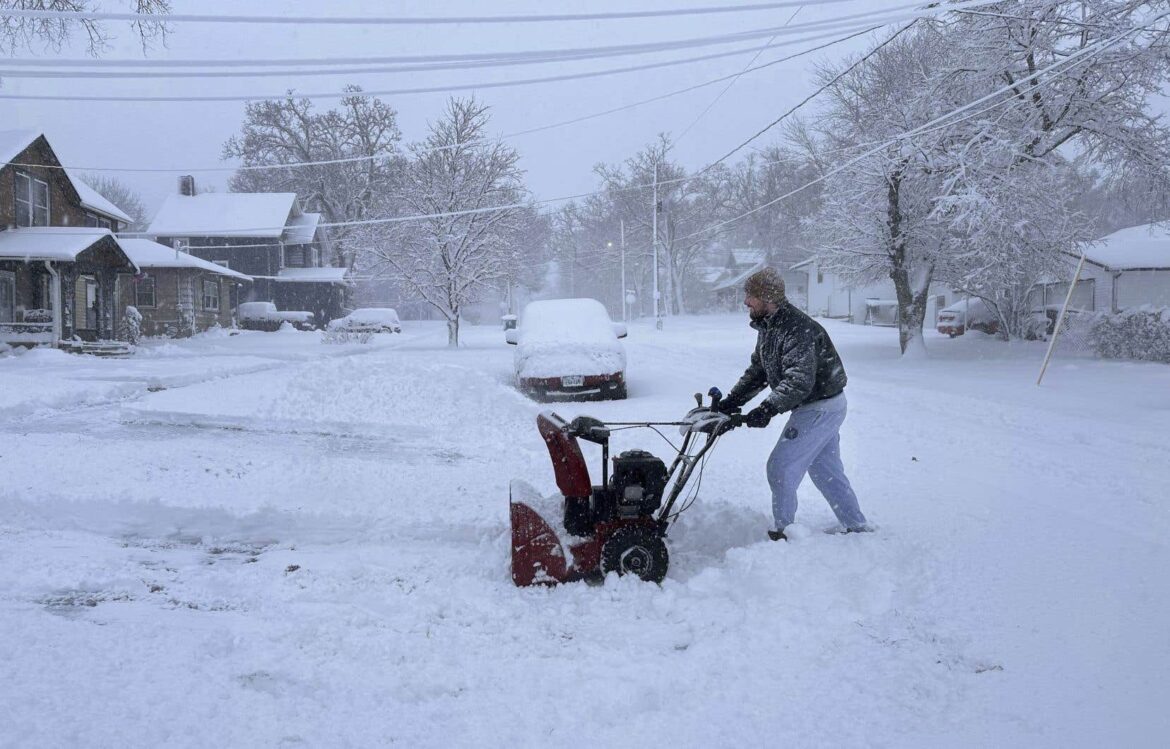A winter storm battered the southern United States on Tuesday with severe thunderstorms and tornado warnings that tore off roofs and scattered furniture.
Another storm grounded Midwestern towns under about six inches of snow, stranding people on highways.
In the South, the severe storm, with winds approaching 90 kilometers per hour and hail, moved across the Florida Panhandle and into parts of Alabama and Georgia by sunrise Tuesday, accompanied by several reports of radar-confirmed tornadoes, the National Weather Service said. A gust of 170 kilometers per hour was recorded before dawn near the coast in Walton County, Florida.
“We still have potentially strong storms in this area through Tuesday morning and the potential for more severe weather and tornadoes,” warned meteorologist Lance Franck in Tallahassee.
Footage shot by local television in Panama City Beach, Florida, shows parts of roofs blown away, furniture, fences and debris strewn about, as well as a house that appeared to be tilted on its side, leaning on another House.
Several centimeters of snow
In Panama City, about 10 miles away, police early Tuesday asked residents to stay indoors and off the roads “unless absolutely necessary” as officers checked the damage. caused by storms, including power lines and uprooted trees.
The city is in Bay County, where numerous tornadoes were reported on the ground, Sheriff Tommy Ford said in a brief message on Facebook Live.
“We rescued people from the structures,” he added.
The department urged people to stay home, releasing photos of a damaged apartment complex and marina.
The Walton County Sheriff’s Office in Florida’s Panhandle region released photos of power lines draped across a road, damage to a gas station and large pieces of construction materials littering the area.
About 70 miles to the northeast, in Jackson County, Florida, photos were released showing damage to a campground and RV park in Marianna.
Florida Governor Ron DeSantis issued an executive order to place 49 counties in North Florida under a state of emergency due to tornadoes.
Heavy rains in Georgia disrupted air traffic at the Atlanta airport for a period Tuesday morning and caused flash flooding, blocking some lanes on highways around Atlanta during commuters’ commutes. the morning. More than 80 Georgia public schools canceled classes, while others held classes online or delayed the start of in-person classes.
Some 265,000 customers were without power in Florida, Alabama and Georgia as of Tuesday afternoon, according to the PowerOutage.us website.
In North Carolina, Governor Roy Cooper declared a state of emergency before the storm approached.
Up to 30 cm expected in the Midwest
In the Midwest, where a snowstorm began Monday, up to 30 centimeters of flakes could cover a wide area stretching from southeastern Colorado to Michigan’s Upper Peninsula, including western Kansas, l Eastern Nebraska, large parts of Iowa, northern Missouri and northwestern Illinois, said Bob Oravec, a forecaster with the National Weather Service in College Park, Maryland.
From there, the storm is expected to track east, bringing a combination of snow, rain and strong winds to the Northeast by Tuesday evening, as well as concerns about flooding in areas such as New -England, parts of which received more than 30 centimeters of snow on Sunday.
About twenty centimeters of snow fell on Monday in the town of Athol, Kansas, in the north of the country. The weather service office in Lincoln, Nebraska, said additional snowfall of up to 10 centimeters was possible overnight, with gusts up to 65 kilometers per hour.
Whiteout conditions in central Nebraska led to the closure of a long stretch of Interstate 80, while Kansas closed Interstate 70 from the central town of Russell to the Colorado border due to dangerous driving conditions. Several vehicles slid off Highway 70 in the northeastern part of the state, authorities said.
In Nebraska, federal courts in Omaha and Lincoln closed Monday, and the U.S. Army Corps of Engineers increased the flow of water from a dam on the Missouri River on the Nebraska-Nebraska border. South Dakota, near Yankton, to reduce the risk of ice jams forming. Dubuque, on Iowa’s eastern border with Illinois, closed its offices Tuesday. Schools in Cedar Rapids, in eastern Iowa, also closed.
The weather has already affected campaigning for the Jan. 15 Iowa caucuses, where snow is expected to be followed by freezing temperatures that could dip to nearly minus 20 degrees Celsius.
She forced former President Donald Trump’s campaign to cancel several appearances by Arkansas Gov. Sarah Sanders and her father, former Arkansas Gov. Mike Huckabee, that had been scheduled to court Iowa voters on behalf of Mr. Trump on Monday.
Parts of northern Missouri prepared for up to a foot of snow as the system moved east. Kansas City officials announced that City Hall would be closed Tuesday and municipal courts would operate remotely.
Madison, Wisconsin, was under a winter storm warning through early Wednesday, with up to 10 inches of snow and winds of 40 miles per hour. Municipal authorities have canceled garbage collection to prevent residents from placing their trash cans along the sidewalks, which would complicate the task of snow plows.
Northwest Illinois was also under a winter storm warning, with forecasts calling for 8 to 12 inches of snow by early Wednesday. The Chicago area as well as Gary, Indiana, are under a winter storm warning, with forecasts calling for up to 15 centimeters of snow and gusts of up to 50 kilometers per hour. Snowfall could exceed one centimeter per hour on Tuesday, according to the weather service.
Snowfall could exceed 2.5 centimeters per hour on Tuesday, according to the weather service.
Disturbances extended to southern Oklahoma, where emergency officials in Cimmaron County asked citizens to stay home. More than a dozen motorists remained stranded Monday afternoon as high winds and blizzard conditions led to near-zero visibility.
Another storm is on the way and will affect the Pacific Northwest up to the northern Rockies. Blizzard warnings were issued for much of the Cascade and Olympic ranges in Washington and Oregon.



